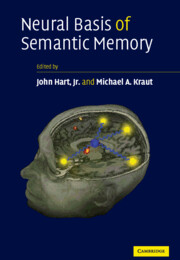Book contents
- Frontmatter
- Contents
- List of contributors
- Preface
- Part I Semantic Memory: Building Models from Lesions
- Part II Insights from Electrophysiology
- Part III Applications of Models to Understanding Cognitive Dysfunction
- Part IV Representations of Nouns and Verbs vs. Objects and Actions
- Part V Critical Role of Subcortical Nuclei in Semantic Functions
- 9 Role of the basal ganglia in language and semantics: supporting cast
- Part VI Conceptual Models of Semantics
- Index
- References
9 - Role of the basal ganglia in language and semantics: supporting cast
from Part V - Critical Role of Subcortical Nuclei in Semantic Functions
Published online by Cambridge University Press: 14 September 2009
- Frontmatter
- Contents
- List of contributors
- Preface
- Part I Semantic Memory: Building Models from Lesions
- Part II Insights from Electrophysiology
- Part III Applications of Models to Understanding Cognitive Dysfunction
- Part IV Representations of Nouns and Verbs vs. Objects and Actions
- Part V Critical Role of Subcortical Nuclei in Semantic Functions
- 9 Role of the basal ganglia in language and semantics: supporting cast
- Part VI Conceptual Models of Semantics
- Index
- References
Summary
The role of the basal ganglia in language and semantics has been debated since Broadbent (1872), Wernicke (1874), Kussmaul (1877) and Marie (1906) first addressed the topic. Interest was resurrected in the late 1950s and 1960s when the pallidotomies were conducted for relief of Parkinson's disease. After dominant pallidotomy, some patients demonstrated aphasia (Svennilson et al., 1960). Further, stimulation of the dominant globus pallidus during operative procedures interrupted ongoing language (Hermann et al., 1966), and stimulation of the dominant caudate head produced phrases and short sentences not relevant to the ongoing situation (Van Buren, 1963, 1966; Van Buren et al., 1966). Interest peaked in the late 1970s and 1980s, as use of computerized tomography (CT) scans demonstrated basal ganglia infarcts and hemorrhages in the dominant hemisphere that were accompanied by aphasia (Brunner et al., 1982; Cappa et al., 1983; Damasio et al., 1982; Fisher, 1979; Hier et al., 1977; Knopman et al., 1984; Murdoch et al., 1989; Wallesch, 1985, to mention a few).
Much has happened since the latter studies to clarify the role of the basal ganglia in language and semantics. Now, it can be definitively stated that the basal ganglia are not directly involved in primary language or semantic functions. Yet it is becoming equally clear that the basal ganglia play a pervasive, but subtle role in cognitive processing that cuts across a number of functions.
Keywords
- Type
- Chapter
- Information
- Neural Basis of Semantic Memory , pp. 219 - 244Publisher: Cambridge University PressPrint publication year: 2007
References
- 16
- Cited by



